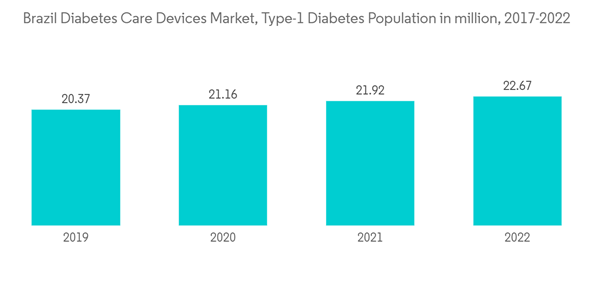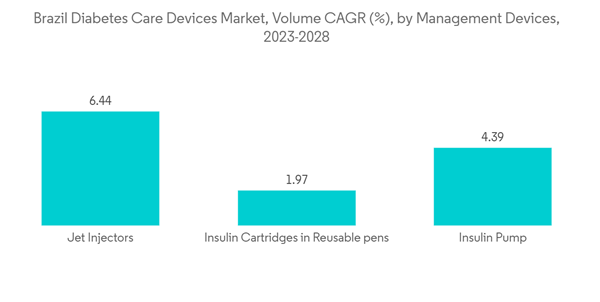The COVID-19 pandemic has had a notable impact on the diabetes care devices market. Diabetes is a chronic condition demanding self-management and care, which involves regular attention to food, physical activity, blood sugar monitoring, and the use of medications. People with chronic diseases such as diabetes mellitus and obesity have a worse prognosis of COVID-19. Diabetic people are twice more likely to have their comorbid conditions worsened, and consequently to die. The healthcare system must be better organized for more severe cases of COVID-19 as studies suggest that inadequate glycemic control increases the risk of undesired outcomes in diabetic patients with SARS-CoV-2 infection. The prevalence of diabetes in people hospitalized with COVID-19 infection and the recognition that improved glycemic control might improve outcomes and reduce the length of stay in patients with COVID-19 have underlined the importance of diabetes care devices.
According to IDF Diabetes Atlas 2021, 15.7 million adults about 10.5% are currently living with diabetes in Brazil - or one in ten adults. The cost of diabetes-related health expenditure in Brazil is the third highest in the world, at 42.9 billion USD. In addition, 18 million adults around 11.9% have Impaired Glucose Tolerance which places them at high risk of developing type 2 diabetes. 32% of people living with diabetes in Brazil are undiagnosed. Additional data on glycaemic control in Brazil show that only 25% met the therapeutic goal of glycated haemoglobin (HbA1c)< 7% before the pandemic, as recommended by the Brazilian Diabetes Society (SBD).
Brazil has implemented a set of reforms over the past to improve the distribution of doctors, develop new forms of service organization, introduce new financing models, and implement a range of quality improvement initiatives and policy frameworks to overcome risk factors such as obesity and emerging pandemic threats. This also highlights opportunities for continuing and expanding innovations in the delivery of diabetes care and the use of diabetes technology.
Brazil Diabetes Care Devices Market Trends
The continuous glucose monitoring segment is expected to witness a healthy growth rate over the forecast period
The continuous glucose monitoring segment is expected to record USD 420 million in revenue with a CAGR of 11.9% over the forecast period.Continuous Glucose Monitoring Devices are automated glucose monitoring systems with small devices that can be worn on the body and held on by an adhesive patch. The sensor part of the device contains a cannula inserted into the top layer of skin and uses interstitial fluid samples to check glucose levels. Sensors are connected to a transmitter that can send data wirelessly to a dedicated mobile receiving device or smartphone. Continuous glucose monitoring sensors use glucose oxidase to detect blood sugar levels. Sensors are the most important part of continuous glucose monitoring devices. Technological advancements to improve the accuracy of the sensors are expected to drive segment growth during the forecast period.
Using CGMs for people with Diabetes and their caregivers and communities is beneficial for managing their blood glucose and insulin levels to maintain their health outcomes. CGM makes it significantly easier to manage blood glucose levels by decreasing interruptions, allowing better sleep, and improving the mental health of patients or caregivers by reducing the overall mental load of managing Diabetes. CGMs are widely used in children with Type-1, enabling parents to feel safer. It allows other adults to care for their child, giving children more freedom and autonomy in their day-to-day lives and enabling access to more normal experiences and opportunities.
The various initiatives by the Brazilian government are expected to drive the market's growth. The Federal Government of Brazil partnered with numerous private companies to primarily utilize their supply chain (manufacturing, distribution, and retailers) to ensure low device prices. Furthermore, continuous glucose monitoring devices are becoming cheaper with the advent of new technologies, like cell phone integration. It is likely to drive the segment growth during the forecast period.
Insulin disposable pens held the highest market share in the management devices segment in the current year
Insulin Disposable Pens occupied the highest market share of about 58% in the management devices segment in the current year.A disposable insulin pen contains a prefilled amount of insulin. When the pen is empty, it is thrown away. Insulin pens are much smaller and more portable than syringes, including the medicine preloaded into the delivery mechanism. The needles are easy to use and can be disposed of by twisting or snapping. The pens are usually color-coded, making it easier to know which type and how much insulin can be received from them. The disposable insulin pens are considered more consumer-friendly, as they are smaller and less noticeable than the classic vial-and-syringe. These devices are also more portable for consumers. Some pens are smart insulin pens that easily connect to an app on the phone to monitor blood sugar levels. It also reminds the person when to take the next insulin dose.
The high prevalence of diabetes is associated with a significant economic burden. The costs of diabetes are increased in patients with co-morbidities such as hypertension and hyperlipidemia and in patients who develop complications. Costs increase with an increasing number of complications. The Ministry of Health established a list of medications and supplies the Brazilian Health System provides to patients with diabetes. However, their supply is usually insufficient or recommended for optimal patient management across cities. In Brazil, the public health system Sistema Único de Saúde (SUS) is progressively increasing the assistance available for individuals with diabetes. Such factors helped the increased adoption of these products in the Brazilian market.
Brazil Diabetes Care Devices Industry Overview
The Brazilian diabetes care devices market is semi-consolidated, with major manufacturers like Roche, Abbott, Novo Nordisk, Dexcom, Medtronic, and other generic players.Additional Benefits:
- The market estimate (ME) sheet in Excel format
- 3 months of analyst support
This product will be delivered within 2 business days.
Table of Contents
Companies Mentioned (Partial List)
A selection of companies mentioned in this report includes, but is not limited to:
- Abbott Diabetes Care
- Roche Diabetes Care
- LifeScan (Johnson & Johnson)
- Sanofi
- Medtronic
- Novo Nordisk A/S
- Terumo
- Eli Lilly
- Arkray
- Becton Dickinson
- Dexcom










